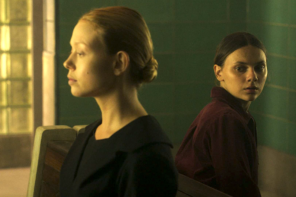Daybreakers, the new science-fiction/horror film by the Spierig brothers, drips with social commentary as well as gore. It is 2019 and 95% of Americans have become vampires. In this futuristic world traffic signs read, “School Zone 2 a.m.-3 a.m.,” bloody coffee can be purchased at Starbucks, and LCD displays are used as vanity mirrors for those who cast no reflection. Humanity has seemingly conquered death, as vampires are impervious to disease or aging.
Non-vampires are captured by the military, turned over to the Bromley-Marks corporation, and farmed for their blood. But the dwindling population of normal humans can no longer support the ever-growing vampire majority. To make matters worse, blood deprivation causes vampires to degenerate into “subsiders”—hideous bat-like monsters.
Edward Dalton (Ethan Hawke) is a scrupulous vampire hematologist, working for Bromley-Marks to create a blood substitute for the vampire population. However, the company only seeks to prop up the status quo and has no intention of giving up its monopoly trading in human blood. Dalton becomes a renegade after meeting Lionel “Elvis” Cormac (Willem Dafoe), who has discovered a cure for vampirism, which would destroy the corporate power structure, leading to a deadly struggle for the fate of the human race.
While Hawke described Daybreakers as “completely unpretentious and silly,” it can be read as an allegory for a number of social issues. The new society that has seemingly transcended mortality is actually unsustainable and built upon a foundation of human suffering. The blood shortage seems an obvious reference to fears about oil depletion and projected shortages of potable water, while images of American soldiers sporting fangs and glowing eyes may be a critique of US imperialism.
The plight of the mutated subsiders bears a strange resemblance to the current debate over health care. Because wealthy vampires can afford enough blood to stay healthy, it is only the poor who sicken and become ravening monsters. As the blood crisis worsens, the government can no longer justify giving blood rations to maintain the subsiders. The solution is to literally kill the poor. A scene in which the military drags columns of wretched, impoverished vampires into the sun was strangely reminiscent of Congressman Alan Grayson’s accusation that the Republican health care plan was to “die quickly.”
This take on vampirism is hardly original. Vampires have been synonymous with the evils of capitalism for over three hundred years. In fact, the oldest use of the word “vampire” in English appears in a text from 1688 that describes a group of traders as “Vampires of the Publick.” Two hundred years later, Karl Marx compared capitalism to vampirism in Das Kapital. Corporate power structures have also played a strong role in modern vampire films like Blade (1998) and Ultraviolet (2006).
What is original about Daybreakers is how the vampire society is undone. While the film does feature human guerillas armed with crossbows, the world is redeemed not by the martial prowess of vampire slayers, but by the moral strength of the vampires themselves. This aspect of the plot, combined with the tropes of blood drinking, death, and immortality endemic to the genre, made for a surprisingly Christian message about martyrdom and social justice.
The idea that a single person can cure a world of vampires by sharing their blood first appeared in Richard Mattheson’s novel I Am Legend (1954). This story took on obvious Christ-like imagery when it was adapted into Omega Man (1971). In this film, Charlton Heston’s character is killed with a spear so that his blood might redeem mankind. The Spierig Brothers chose to skirt direct Christian iconography in favor of a more neutral image of death and rebirth. According to Hawke, the brothers see the journey of the protagonists as “the phoenix story.” Elvis, the first vampire to regain his humanity, drives a firebird stenciled with the words “from the ashes springs new life.”
Still, Christian themes of martyrdom and communion permeate the story. Restoring a vampire’s mortality can only be accomplished through a tremendously painful ordeal. However, the characters learn that drinking the blood of a redeemed vampire is itself a cure for vampirism, allowing them to “bless those who persecute them.” In one of the most violent scenes in the film, a redeemed vampire throws himself to a mob of bloodthirsty soldiers as an act of martyrdom. In a sort of gory communion, his death causes the soldiers feasting on his blood to become human. These converted soldiers are themselves descended on and devoured by their vampire comrades.
This cycle creates a kind of chain reaction as wave after wave of soldiers are restored to humanity and then dismembered. Of course, this scene can be read simply as the grim and silly logic of horror movies. But it also seems indebted to a Christian tradition of conversion and martyrdom going back to the days of the early church. The soldiers who hunt humanity become human themselves, die, and spread this condition to others. Ultimately, the film’s title seems to refer to the heroes’ ability to transform themselves and thereby to transform society. Even if we are part of a vampiric society, as long as we have the ability to see the world through the eyes of those we prey on, redemption is still possible.



